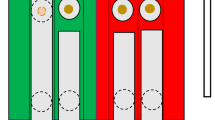Abstract
In Experiment 1, six capuchins lifted a weight during a 10-min session to receive a food piece. Across conditions, the weight was increased across six different amounts for three different food types. The number of food pieces obtained as a function of the weight lifted was fitted by a demand equation that is hypothesized to quantify food value. For most subjects, this analysis showed that the three food types differed little in value. In Experiment 2, these monkeys were given pairwise choices among these food types. In 13 of 18 comparisons, preferences at least equaled a 3-to-1 ratio; in seven comparisons, preference was absolute. There was no relation between values based on degree of preference versus values based on the demand equation. When choices in the present report were compared to similar data with these subjects from another study, between-study lability in preference emerged. This outcome contrasts with the finding in demand analysis that test–retest reliability is high. We attribute the unreliability and extreme assignment of value based on preference tests to high substitutability between foods. We suggest use of demand analysis instead of preference tests for studies that compare the values of different foods. A better strategy might be to avoid manipulating value by using different foods. Where possible, value should be manipulated by varying amounts of a single food type because, over an appropriate range, more food is consistently more valuable than less. Such an approach would be immune to problems in between-food substitutability.






Similar content being viewed by others
References
Addessi E, Mancini A, Crescimbene L, Ariely D, Visalberghi E (2010) How to spend a token? Trade-offs between food variety and food preference in tufted capuchin monkeys (Cebus apella). Behav Process 83:267–275
Beran MJ, Savage-Rumbaugh ES, Pate JL, Rumbaugh DM (1999) Delay of gratification in chimpanzees (Pan troglodytes). Dev Psychobiol 34:119–127
Brosnan SF, de Waal FB (2003) Monkeys reject unequal pay. Nature 425:297–299
Casey AH, Silberberg A, Paukner A, Suomi SJ (2014) Defining reward value by cross-modal scaling. Anim Cogn 17:177–183
Cassidy RN, Dallery J (2012) Effects of economy type and nicotine on the essential value of food in rats. J Exp Anal Behav 97:183–202
Clark FC (1958) The effect of deprivation and frequency of reinforcement on variable-interval responding. J Exp Anal Behav 1:221–228
Elsmore TF, Fletcher GV, Conrad DG, Sodetz FJ (1980) Reduction of heroin intake in baboons by an economic constraint. Pharmacol Biochem Be 13:729–731
Evans TA, Beran MJ (2007) Delay of gratification and delay maintenance by rhesus macaques (Macaca mulatta). J Gen Psychol 134:199–216
Fehr E, Schmidt KM (1999) A theory of fairness, competition, and cooperation. Q J Econ 114:817–868
Hastjarjo T, Silberberg A (1992) Effects of reinforcer delays on choice as a function of income level. J Exp Anal Behav 57:119–125
Henrich J (2004) Animal behaviour (communication arising): inequity aversion in capuchins? Nature 428:139
Herrnstein RJ (1970) On the law of effect. J Exp Anal Behav 13:243–266
Hursh SR (1978) The economics of daily consumption controlling food-and water-reinforced responding. J Exp Anal Behav 29:475
Hursh SR (1980) Economic concepts for the analysis of behavior. J Exp Anal Behav 34:219–238
Hursh SR, Silberberg A (2008) Economic demand and essential value. Psychol Rev 115:186–198
Hursh SR, Winger G (1995) Normalized demand for drugs and other reinforcers. J Exp Anal Behav 64:373–384
Krantz DH (1964) Conjoint measurement: the Luce-Tukey axiomatization and some extensions. J Math Psychol 1:248–277
McAuliffe K, Chang LW, Leimgruber KL, Spaulding R, Blake PR, Santos LR (2015) Capuchin monkeys, Cebus apella, show no evidence for inequity aversion in a costly choice task. Anim Behav 103:65–74
Raslear TG, Bauman A, Hursh SR, Shurtleff D, Simmons L (1988) Rapid demand curves for behavioral economics. Anim Learn Behav 16:330–339
Roma PG, Silberberg A, Ruggiero AM, Suomi SJ (2006) Capuchin monkeys, inequity aversion, and the frustration effect. J Comp Psychol 120:67–73
Sheskin M, Ashayeri K, Skerry A, Santos LR (2014) Capuchin monkeys (Cebus apella) fail to show inequality aversion in a no-cost situation. Evol Hum Behav 35:80–88
Silberberg A, Crescimbene L, Addessi E, Anderson JR, Visalberghi E (2009) Does inequity aversion depend on a frustration effect? A test with capuchin monkeys (Cebus apella). Anim Cogn 12:505–509
Skinner BF (1932a) Drive and reflex strength. J Gen Psychol 5:22–37
Skinner BF (1932b) Drive and reflex strength: II. J Gen Psychol 7:38–48
Winer BJ (1971) Statistical principles in experimental design. McGraw-Hill, New York
Author information
Authors and Affiliations
Corresponding author
Rights and permissions
About this article
Cite this article
Schwartz, L.P., Silberberg, A., Casey, A.H. et al. Scaling reward value with demand curves versus preference tests. Anim Cogn 19, 631–641 (2016). https://doi.org/10.1007/s10071-016-0967-4
Received:
Revised:
Accepted:
Published:
Issue Date:
DOI: https://doi.org/10.1007/s10071-016-0967-4




